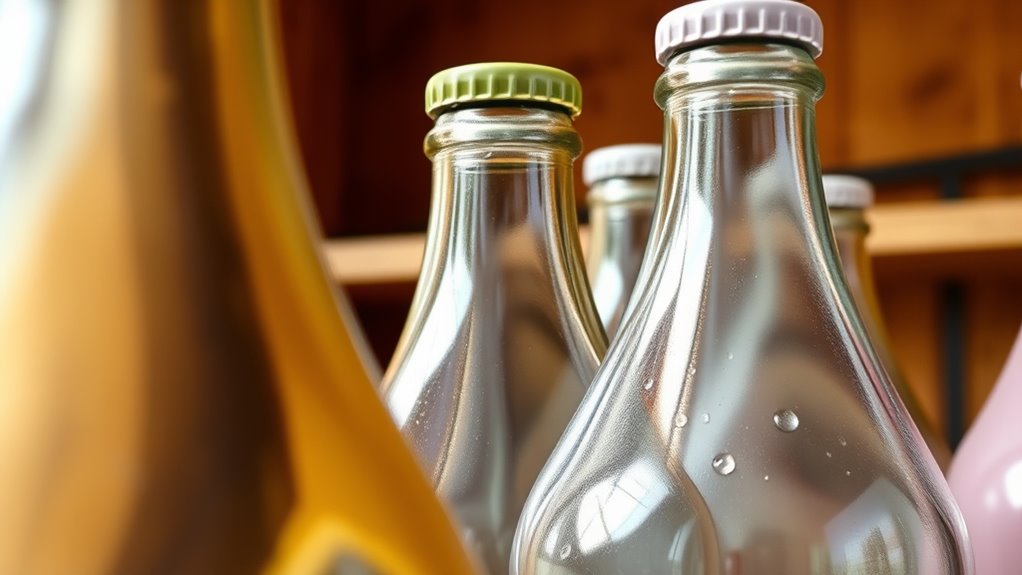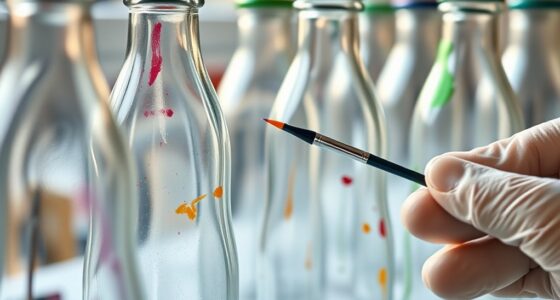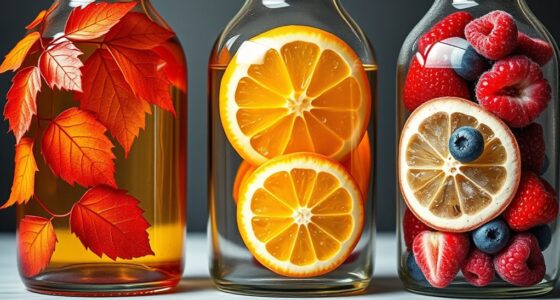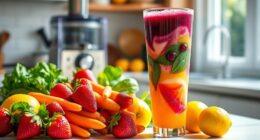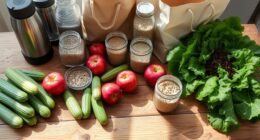For the outside of bottles, choose food-safe finishes like natural oils, beeswax, or shellac, which create a protective and safe barrier. Non-toxic coatings designed for food contact, such as FDA-approved sprays or brushes, provide durability, moisture resistance, and an attractive appearance. Make certain to select finishes labeled as food-safe, biodegradable, and environmentally friendly. Want to discover more about the best options and application tips? Keep exploring to find out how to guarantee safety and style.
Key Takeaways
- Use natural finishes like beeswax or mineral oils that are labeled food-safe and environmentally friendly.
- Choose non-toxic coatings free from VOCs, synthetic additives, and harmful solvents for exterior bottle surfaces.
- Ensure finishes are FDA-compliant and specifically designed for food-contact exterior applications.
- Follow manufacturer instructions for proper application, curing time, and durability to maintain safety.
- Prioritize finishes that resist moisture, scratches, and wear to protect the bottle’s appearance and safety.
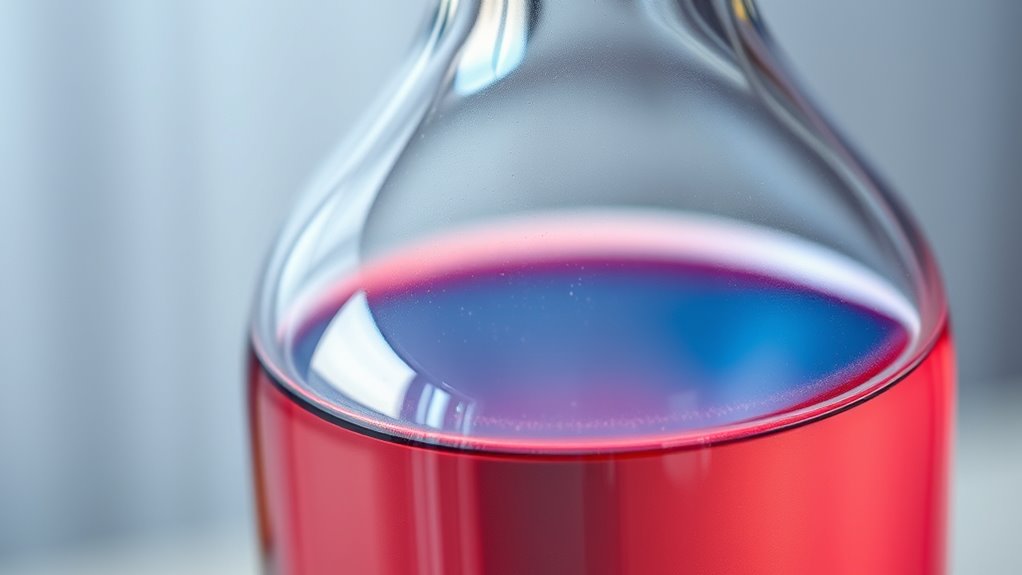
When choosing finishes for food-contact surfaces, safety should be your top priority. This is especially important when you’re working on the outside of bottles or other food containers, where the finish not only impacts appearance but also plays a vital role in safety and durability. Natural food finishes are an excellent option because they are derived from organic sources and generally free of harmful chemicals. These finishes often include plant-based oils, beeswax, or shellac, which can create a protective, food-safe coating that enhances the look of your bottles without risking contamination. Non toxic coatings, on the other hand, are specially formulated to be safe for contact with food and beverages, making them ideal for exterior finishes. They tend to be free of toxic solvents, volatile organic compounds (VOCs), and synthetic additives, providing peace of mind that your finished product is safe for everyday use.
Choosing natural food finishes means you prioritize a more environmentally friendly approach, often resulting in finishes that are biodegradable and less harmful to the environment. For example, food-grade mineral oils or beeswax can be melted and applied to the surface of your bottles, creating a water-resistant barrier that’s safe for contact with food and drinks. These finishes also tend to enhance the natural beauty of the material, giving your bottles a warm, organic look. When applying natural food finishes, it’s vital to ensure they are pure, unadulterated, and specifically labeled as food-safe. This guarantees that no harmful chemicals or additives are present, maintaining the integrity of the food contact surface.
Non toxic coatings are formulated to meet strict safety standards, making them a reliable choice for finishing bottles that hold consumables. They often come in spray or brush-on forms, making application straightforward. Look for finishes that are explicitly labeled as food-safe or compliant with FDA regulations, which signifies they are suitable for food-contact surfaces. These coatings typically form a durable, yet non-toxic, protective layer that resists moisture, scratches, and other wear, extending the lifespan of your bottles without compromising safety. When selecting a finish, read the manufacturer’s instructions carefully to guarantee proper application and curing times, which are vital for creating a safe, long-lasting surface.
Frequently Asked Questions
Are Food-Safe Finishes Suitable for Dishwasher Cleaning?
Yes, food-safe finishes can be dishwasher safe, but you need to verify their durability. Some finishes are designed for dishwasher durability, so they resist frequent cleaning without peeling or fading. To guarantee finish longevity, follow manufacturer instructions and avoid harsh detergents. Properly applied, these finishes can maintain their appearance through regular dishwasher cycles, keeping your bottles looking good and safe for everyday use.
How Long Do Food-Safe Finishes Last on Bottles?
On average, food-safe finishes on bottles last around 1-3 years, depending on storage conditions. Imagine a reusable water bottle kept in a hot car; the finish might degrade faster than one stored in a cool, shaded spot. Factors like exposure to sunlight, frequent washing, and abrasive cleaners affect finish durability. Proper storage and gentle cleaning help extend the finish’s lifespan, keeping your bottles safe and looking good longer.
Can Food-Safe Finishes Be Applied to Glass Bottles?
Yes, you can apply food-safe finishes to glass bottles, especially when doing decorative painting or bottle labeling. Just make certain you choose a finish specifically labeled as food-safe to prevent contamination. Before applying, clean the bottle thoroughly. Once dried, these finishes can enhance your bottle’s appearance while keeping it safe for food contact. Always follow manufacturer instructions for the best results and longevity.
Are There Any Health Risks With Certain Finishes?
You should be aware that some finishes pose health risks due to chemical leaching or allergic reactions. Certain finishes may release harmful chemicals over time, especially if they aren’t food-safe or properly cured. Always choose finishes labeled as food-safe, and test for allergic reactions if you have sensitive skin. By selecting safe, certified options and applying them correctly, you can reduce health risks and keep your bottles safe for use.
How Do I Test a Finish’s Food Safety at Home?
Your quest for foolproof food safety starts with DIY testing, which can seem as daunting as navigating a labyrinth of unknowns. To assess finish durability and safety, apply a small amount of the finish on a hidden spot, then let it sit for 24 hours. Use a food-safe swab or gentle soap to see if any residue transfers. If it cleans easily, your finish likely passes the test—making your bottles safer for use.
Conclusion
As you finish your bottle, remember that choosing the right food-safe finish is like sealing a secret promise—protecting what’s inside while revealing the beauty of the outside. When you apply that perfect finish, it’s almost as if the bottle quietly whispers safety and care, much like a gentle breeze carrying the scent of fresh fruit. In that simple act, you create a vessel not just for contents, but for trust and craftsmanship that lasts.
Cindy thoroughly researches juicing trends, techniques, and recipes to provide readers with practical advice and inspiration. Her writing style is accessible, engaging, and designed to make complex concepts easy to understand. Cindy’s dedication to promoting the advantages of juicing shines through her work, empowering readers to make positive changes in their lives through the simple act of juicing.

